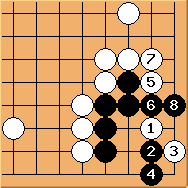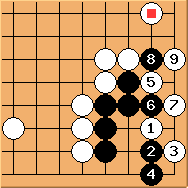All you need to know about Carpenter's Square - 18
This shape is commonly seen in real games. Please consider what white can do?
In this popular joseki, instead of continuing at 'a', black may choose to play a pincer move at right side if conditions are suitable. This may lead to the following:
 may play at
may play at  to secure the corner but white would get a nice wall outside. With some fighting spirit, black can choose this variation. Note that pros always make
to secure the corner but white would get a nice wall outside. With some fighting spirit, black can choose this variation. Note that pros always make  /
/  exchange, rather than playing
exchange, rather than playing  , 'a',
, 'a',  , 'b' sequence - it is very important to leave some aji in the corner. As you may have guessed, the corner is safe for the moment and black can take care of the two outside stones first.
, 'b' sequence - it is very important to leave some aji in the corner. As you may have guessed, the corner is safe for the moment and black can take care of the two outside stones first.
 and
and  create a standard Carpenter's Square. But black can live comfortably by playing 'a', or be more ambitious to play tenuki and get ready for a ko fight.
create a standard Carpenter's Square. But black can live comfortably by playing 'a', or be more ambitious to play tenuki and get ready for a ko fight.
This diagram shows the normal development. Although  is the urgent point, there is not much white can do in this corner. Pros often make
is the urgent point, there is not much white can do in this corner. Pros often make  /
/ 
 /
/  exchanges first, leaving the
exchanges first, leaving the  and
and  yose to play at a much later time.
yose to play at a much later time.
Why do pros like to keep these exchanges? This shows one possibility. If white somehow gets  in sente during mid-game, a ko fight can be created. This is exactly what happened in this pro game (
in sente during mid-game, a ko fight can be created. This is exactly what happened in this pro game ( , move 117 onward), where Rin Kaiho exploited the corner aji and won an important Tengen title match game.
, move 117 onward), where Rin Kaiho exploited the corner aji and won an important Tengen title match game.
If  attacks here, black can form a seki by occupying the key point
attacks here, black can form a seki by occupying the key point  .
.
 is possible too. The result is also a seki.
is possible too. The result is also a seki.
Conclusion: black corner is alive. Both sides need to be aware of the aji in the corner.








